Trees Birds Mammals Fish Amphibians Reptiles
Wild Algarve
Bookshop
Leratiomyces squamosus (Pers.) Bridge & Spooner - Slender Roundhead
Phylum: Basidiomycota - Class: Agaricomycetes - Order: Agaricales - Family: Strophariaceae
Distribution - Taxonomic History - Etymology - Toxicity - Identification - Reference Sources
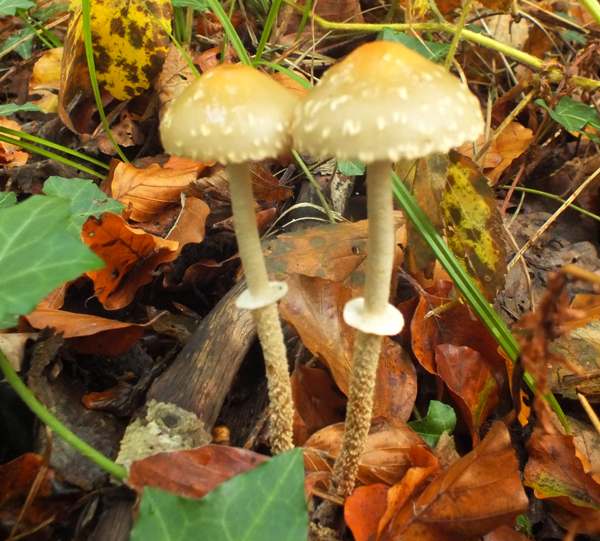
Seen from the top, this attractive little mushroom could easily be mistaken for Sulphur Tuft Hypholoma fasciculare, but it has a substantial and persistent stem ring.
Distribution
The Slender Roundhead Leratiomyces squamosus var. squamosus is an occasional find in England, Scotland, Ireland and Wales (where it is recorded very occasonally in the east). Leratiomyces squamosus var. thraustus is a much rarer find in Britain and Ireland, where it does not have a generally-accepted English name. The autonomous variety is quite a common find in deciduous and mixed woodlands in Germany, Poland, France and several other countries in central mainland Europe; it is also an occasional find in Scandinavia and in som eMediterranean countries as well as North Africa. Leratiomyces squamosus var. thraustus seems to be the more common variety in North America, where both variety are known to occur.
In warm coastal areas of France Leratiomyce squamosus sometimes carpets the forest floor beneath pines and other conifers where there is sawdust and wood chip from thinning and felling. Elsewhere in central and southern mainland Europe this attractive little mushroom is a very common sight on heaps of sawdust on roadside verges where trees have been felled.
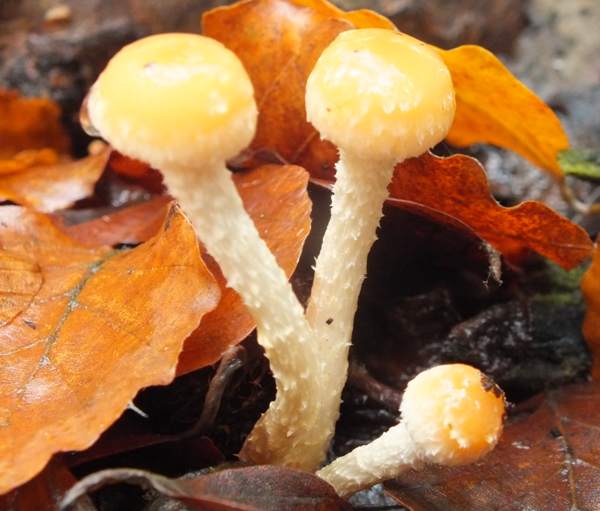
Taxonomic history
When in 1888 British mycologists Mordecai Cubitt Cooke and George Edward Massee (1850 - 1917) described this species, they gave it the binomial scientific name Agaricus squamosus. (In the early days of fungal taxonomy most gilled fungi were initially placed in the genus Agaricus, the contents of which has since redistributed across many other newer genera.)
In 2008 Brian Spooner and colleagues established the currently-accepted scientific name of this mushroom as Leratiomyces squamosus.
Synonyms of Leratiomyces squamosus include
Agaricus squamosus Pers., Syn. meth. fung. (Göttingen) 2: 409 (1801) Psalliota squamosa (Pers.) P. Kumm., Führ. Pilzk. (Zerbst): 73 (1871) Stropharia squamosa (Pers.) Quél., Mém. Soc. Émul. Montbéliard, Sér. 2 5: 348 (1873) Stropharia squamosa (Pers.) Quél., Mém. Soc. Émul. Montbéliard, Sér. 2 5: 348 (1873) var. squamosa Geophila squamosa (Pers.) Quél., Enchir. fung. (Paris): 111 (1886) Naematoloma squamosum (Pers.) Singer, Sydowia 2(1-6): 36 (1948) var. squamosum Naematoloma squamosum (Pers.) Singer, Sydowia 2(1-6): 36 (1948) Psilocybe squamosa (Pers.) P.D. Orton, Notes R. bot. Gdn Edinb. 29(1): 80 (1969) Psilocybe squamosa (Pers.) P.D. Orton, Notes R. bot. Gdn Edinb. 29(1): 80 (1969) var. squamosa Hypholoma squamosum (Pers.) Urbonas [as 'squamosa'], Liet. TSR Mokslu Akad. Darb., Ser. C 4(no. 72): 12 (1975) Hypholoma squamosum (Pers.) Urbonas, Liet. TSR Mokslu Akad. Darb., Ser. C 4(no. 72): 12 (1975) var. squamosum Stropholoma squamosum (Pers.) Balletto [as 'squamosus'], Micol. Ital. 18(1): 36 (1989) Stropholoma squamosum (Pers.) Balletto, Micol. Ital. 18(1): 36 (1989) var. squamosum Hypholoma squamosum (Pers.) Urbonas [as 'squamosa'], Lietuvos Grybai (Vilnius) 8(3): 128 (1999) Stropholoma squamosum (Pers.) Ryman [as 'squamosa'], Funga Nordica, Agaricoid, Boletoid and Cyphelloid Genera (Gylling): 913 (2008)
Etymology
This genus name originated in 1907 when Narcisse Théophile Patouillard created the name Le Ratia (which he applied to a puffball fungus) in honour of French botanist and plant collector Auguste-Joseph Le Rat (1872 - 1910), who on various occasions had provided Patouillard with fungal specimens that he had collected. From this origin Spooner and colleagues derived the new genus name Leratiomyces.
The specific epithet squamosus is a reference to the (usually!) cherry red colour of caps of the Redlead Roundhead.
Toxicity
Despite an attractive appearance, this inedible species is likely to cause an upset stomach if it is eaten. (The very similar Leratiomyces squamosus is known to contain hallucinogenic psilocybin/psilocin.)
Identification guide
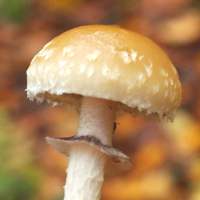 |
Cap
Yellowish ochre to pale orange; convex, becoming flatter when old; pale veil fragments usually cling to cap, especially towards the margin; 2 to 6cm across. |
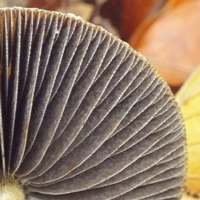 |
Gills
Adnate; fairly crowded; initially grey-brown becoming mottled purplish-brown with paler edges.
Stem
6 to 11cm tall and 4 to 9mm diameter, hollow; white at apex, flushed brownish towards base; covered in fibrous white scales below a persistent stem ring. |
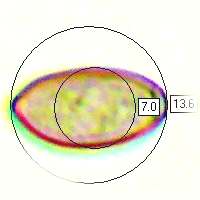 |
Spores
Ellipsoidal, smooth, 11-14 x 6.-8.5; with a germ pore.
Spore print
Purple-brown. |
Odour/taste |
Not distinctive. |
Habitat & Ecological role |
Most often found in alkaline-soil areas on hardwood mulch or in deciduous woodlands where twigs and leaves accumulate in damp grassy or mossy areas. |
Season |
July to November in Britain and Ireland. |
Similar species |
Sulphur Tuft Hypholoma fasciculare often has veil fragments near the cap rim, but they are darker; it also lacks a stem ring. |
Reference Sources
J. Breitenbach, F. Kränzlin: Mushrooms of Switzerland, Volume 4. Publisher Mykologia, Lucerne 1995, ISBN 3-85604-040-4
Dictionary of the Fungi; Paul M. Kirk, Paul F. Cannon, David W. Minter and J. A. Stalpers; CABI, 2008
Taxonomic history and synonym information on these pages is drawn from many sources but in particular from the British Mycological Society's GB Checklist of Fungi.
Top of page...
Fascinated by Fungi. Back by popular demand, Pat O'Reilly's best-selling 450-page hardback book is available now. The latest second edition was republished with a sparkling new cover design in September 2022 by Coch-y-Bonddu Books. Full details and copies are available from the publisher's online bookshop...